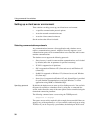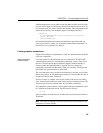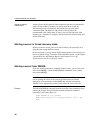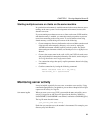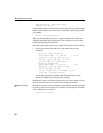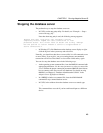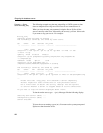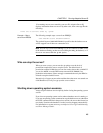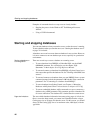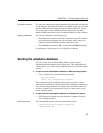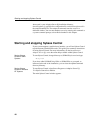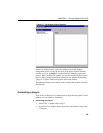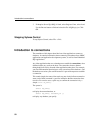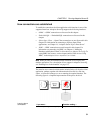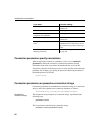
Starting and stopping databases
46
Examples of commands that do not stop a server cleanly include:
• Stopping the process in the Windows NT Task Manager Processes
window.
• Using a UNIX
kill command.
Starting and stopping databases
You can start databases when you start the server, or after the server is running.
To start a database when you start the server, see “Starting the database server”
on page 21 for details.
A database server can have more than one database in use at a time. However,
it is more common to run one database per server, especially in a production
environment.
Starting a database on
a running server
There are several ways to start a database on a running server.
• To start a database from DBISQL or Embedded SQL, use the
START
DATABASE
statement. For a description, see the chapter “SQL
Statements” in the Adaptive Server IQ Reference Manual.
• To start and connect to a database from DBISQL or Sybase Central, use a
data source that specifies the database file. See “Working with ODBC data
sources”.
• To start and connect to a database when you start DBISQL from a system
command prompt, include the parameter
“DBF=
db-file
” in the connection
parameters. See “Connecting to a database from DBISQL”.
• To start a database from Sybase Central, see Chapter 4, “Managing
Databases with Sybase Central” in Introduction to Adaptive Server IQ
• To start an embedded database, while connected to a server, connect to a
database using a DBF parameter. This parameter specifies a database file
for a new connection. The database file is loaded onto the current server.
Page size limitations
The server holds database information in memory using pages of a fixed size.
Once a server has been started, you cannot load a database that has a larger
Catalog page size or IQ page size than the server. For this reason, you should
always set the Catalog page size to its maximum value, 4096 bytes, with the
-gp switch.



